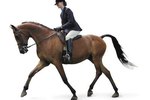Things You'll Need
Spurs
Riding crop
Making a horse run faster is part of the training process where you teach the animal to be responsive to your touch. Horses learn by repetition. Your training methods will always include pressure and release. In order to teach your horse to go faster, you must apply contact in a consistent and reasonable way. This would be true whether you are working with your horse in the round pen, on a lunge line or while mounted. For your own safety, be sure that your horse knows how to stop. You do not want to be riding a horse that does not know how to apply his brakes.
Get your horse tacked up. Once he is fully tacked, take him to the arena and mount.
Warm up your horse. Going from a walk to a hand gallop is the equivalent of getting out of bed in the morning and breaking into a run down the driveway. Your horse needs an appropriate warm up for his muscles. Start off with your regular routine of bending, flexing and stretching him while transitioning up and down within the gaits. This means working in circles, serpentines, and cutting across the diagonal at a walk, trot and canter.
Transition the gaits. While you are warming up, use your aids to cue her to slow down. If your horse is going at the working trot, ask for a bit more collection by half halting. Your horse should respond instantly to this cue and collect her body by shortening her stride. This collection and shortening tell you that she is listening. Now ask her for a working canter. Halfway around the arena, give her a half halt to see if she responds by shortening her canter stride. Now ask her to come down from the canter to a full halt. Squeeze your hands around the reins, sit up straight and put all your weight deeply into the saddle while closing your legs around the horse's barrel. She should respond by giving you a nice halt. If she is listening to you, ask for more.
Speed him up. Ask for a working canter. On the long side of the arena, give your horse the cue to lengthen his stride by applying pressure, squeezing with your calves and heels. He should immediately respond by increasing his speed and lengthening. Make sure that your hands are soft on the reins and allow your horse to move forward. If you hold him back, he will have nowhere to go. If your horse does not increase his speed, apply your spurs by gently pricking upwards into his sides or giving his hindquarters a quick tap with the crop.
Ask for a greater increase. Your horse should now be in a hand gallop, which means that she is galloping but is well within your control. To ask for a full run, apply more leg pressure until your horse is galloping full speed. Be careful that you ask for speed increases only on the long sides of the arena and that as you come into corners and sides, you collect your horse by shortening his stride. When you come to the long side, ask for another increase. Use your spurs and riding crop if your horse does not listen to your request. Expect an immediate response from leg pressure. If she does not listen, apply the spurs or crop.
Tips
Your horse should respond immediately to your aids and cues. Always warm your horse up before you ask him to canter. Riding crops and spurs are wonderful training aids but should not be used to beat or hurt your horse. Never use a crop or spurs in a harsh or cruel manner or you will lose your horse's trust and confidence.
Warnings
Horseback riding is an extremely dangerous sport. Always wear approved, protective head gear when working around and riding horses. If you are not sure about your skills or horse's performance, consult a professional trainer for lessons and guidance. If your horse does not respond to half halts or is not good about halting (stopping), do not ask him to gallop.
Writer Bio
Ashlee Simmons has written professionally for more than 10 years. Her writing focus is travel, equestrian and health and medical articles, but she enjoys writing human interest stories as well. Simmons graduated from The University of Texas at Austin with a liberal arts degree.





